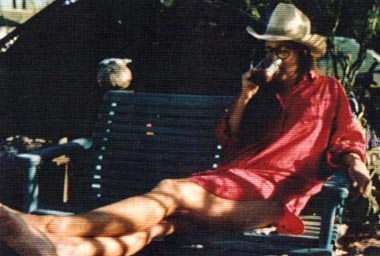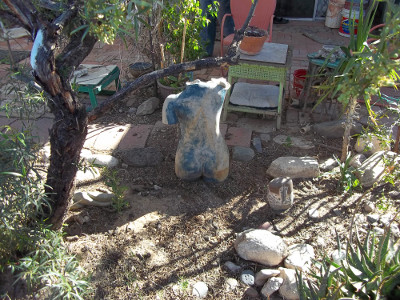Dictionary Definition
Passive: [adjective] acted upon by an external agency. receptive to outside impressions or influences. asserting that the grammatical subject of a verb is subjected to or affected by the action represented by that verb. containing or yielding a passive verb form. lacking in energy or will : lethargic. tending not to take an active or dominant ...
Aggressive: having or showing a bold forcefulness in the pursuit of a goal. Synonyms: ambitious, assertive, enterprising…
My definitions of Passive and Aggressive as it suits this web site. Usually I am not judgemental about which technique is better.
Passive: What I can do myself or with simple materials and technology. I'd consider an awning I built myself with salvaged or simple materials passive. It makes shade and cools my porch without a fan or electricity. Although the building of the awning involves taking action.
Aggressive: Hiring someone and paying big bucks to build an awning. Plugging in a electric fan when I have enough company on the porch and we need more cool. Buying and installing an electric run, water wasting misting system. (Oops I slid into judgemental.) Those misting systems I hear use more water than a swamp cooler.
Passive: Moving bricks from a patio that makes heat in the wrong season to a spot where the bricks are shaded in summer and catch sun in the winter.
Aggressive: Aggressively putting an electric run water wasting misting system. (Oops I slid into judgemental.)
Passive: Sculpting the land to divert rain water to areas that grow plants that shade the property specially the east and west side of the building is passive. The rain water moves by itself where I've directed it with berms or hills. Moving lots of dirt isn't exactly passive, I work up a lot of sweat moving dirt.
Aggressive: Hiring a crew with jack hammers to bust out my caliche cursed dirt for a gray water basin and paying them with more than a french toast breakfast and traded mending for digging.
This is the story of my search for sustainability as an adult when I bought my own property in the late 1970s. I'm amazed at how much time and energy I put into sustainable projects in the 30 years I worked hard to make a living as an artist without outside backing. I bought a tiny house in the late 1970s, enclosed a carport for a clay art studio and began making art, teaching workshops including a “That's Art Biz” business workshop for artists I taught for 20 years and several Artist in the School Projects, several resulted in time murals. I worked on public clay tile murals with other artists or students. I noticed I was using lower tech, waste reducing, low polluting methods in my studio. I developed a low labor low labor method for recycling dried clay, taught workshops, and eventually sold my clay recycling notes on the internet. See HoldReadArt.com for my essays on environmentally responsible art studio procedures.
For years I minimized my yard design because I just didn't have time, then I got interested in growing food and other environmental causes. Yes, growing food in composted soil I make myself, using rain water is an environmental project. I'm minimizing my dependence of commercially grown food. Commercially grown food may include with pesticides, herbicides, chemical polluting fertilizers, gas driven farm equipment, sometimes irrigated with water pumped with electricity generated by coal burning electrical plants, then shipped in gas guzzling refrigerated trucks or GASP shipped in planes, stored in air conditioned stores, that folks drive their cars to shop. Then consider produce packaging uses lots of plastic bags, containers. So much of commercial produce is thrown away in processing if it's irregular in shape, or too ripe before it even leaves the farm. Lots of produce is thrown away at the store if it's damaged, or past it's sell date. SO much waste. My garden waste either goes to the chickens then their by products go to the compost or food waste goes into the compost where it makes more great soil. No pumped water, no plastic packaging, no petro dependent shipping, no refrigerated storage. Growing your own food is a low carbon footprint as well as simple and you can't get fresher than something you've picked 5 minutes ago.
My Studio/yard was well shaded with mesquite trees, I grew veggies in the old bins at my neighbor's property that had winter sun, I used buckets to harvest the rain that ran off their gutter-less house to water my garden in their yard. Of course I shared my lettuce.
I lived in my tiny studio house till 2015 when my mother needed care, her group home wasn't working out, her old home was sitting in Lake Havasu Citywith all her furniture in it but no one living there. I didn't have room in my studio for the furniture I'd inherit. The house across the fence from my studio house was on the market. We bought it, I proposed to my boyfriend and began a new life. My Mom was living with her furniture and family collections again. Now my household had three incomes, Mom's retirement, my art income and my husband's teaching income and retirement. I had more time and money for sustainable projects on the new property as I was home more caring for my mother and making a family life. Life was very good, I enjoyed 6 years of making a home and yard for our family.
Years before when the property across from my studio was bull dozed I was heart broken. I listened to the birds wailing for a week as they perched on the uprooted dying trees, what was once lovely desert was destroyed and sat empty dusty and glaring reflected light on sand, for several years before four manufactured houses were installed. I bought the home that was up against my studio property fence. When I bought our together home the rain water on the property drained to the street. No trace of native plants or trees were left, goat heads infested the property, Bermuda was creeping through the chain link fence. We borrowed a jack hammer and began digging in water harvesting basins and planting native trees, and shrubs. I used the dirt removed from the basins and built up a porch as well as a ramped area for Mom's walker. I laid brick on that ramp. We pulled the cursed Bermuda and laid down 14 layers of newspaper covered with a fine layer of dirt. Twice a year after rains we watch for Bermuda creeping across the fence into our property and get it out by the roots right away. The goat heads were awful, our shoes would pick up 10-15 goat heads every time we stepped outside. NO BARE FOOTING on this property. Inspired by Scarlett O'Hara I brandished a goathead plant under my husbands nose and said. “AS GOD IS OUR WITNESS WE WILL NEVER LET A GOATHEAD TO TO SEED ON OUR PROPERTY AGAIN.”I'm amazed, one rainy season, one year of pulling every goat head plant and now we go barefoot outside. A miracle assisted by perseverance. Cisterns followed with gutters and a few more rain barrels. I started a line of compost bins that I collar up and plant my winter garden over the top. The south side of the compost bins that faces my neighbor's has a wall of decorative blocks and I covered the compost bins with old sheets and painted the bins to match the blocks. (Fabric covered painted plastic compost bins conserve water making the bins suitable for the desert, protect the plastic from the sun, and LOOK GREAT).


The end